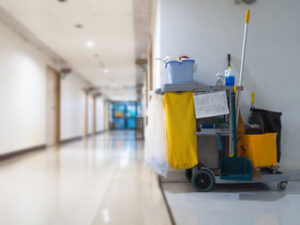Maintaining a clean business can improve customer satisfaction and encourage loyal customers to return to your business or facility. This can increase your income, and can also help you avoid costly repairs by extending the life of your equipment.

Commercial cleaning is different from janitorial services, as it takes place in larger spaces and can involve specialized cleaning standards and methods. The scope of work includes emptying trash cans, sanitizing surfaces and shared equipment, and washing dishes and cleaning kitchen areas. Contact Levdok Services for professional help.
A commercial cleaning company is a type of business that cleans a variety of areas for businesses. These services may include janitorial, office cleaning, carpet cleaning and window cleaning. They also provide additional ad hoc cleaning services for unforeseen situations, such as floods or accidents. The company’s employees must be trained and certified to use heavy equipment, chemicals and cleaning materials. The company must also be able to provide a consistent level of service, which can be difficult for a small business owner to do.
Generally, a commercial cleaning company will offer more extensive cleaning services than a residential cleaning company. They will be able to clean high-traffic areas that get dirty quickly and have special equipment for disinfecting and deep cleaning hard-to-reach places. Some commercial cleaning companies will even handle waste disposal and hazardous cleanup. They will also handle the training and certification of their staff, procurement of cleaning products and supplies, and the maintenance of equipment. The company will be responsible for scheduling and coordinating all of these tasks, so it can concentrate on providing its customers with a high-quality cleaning service.
In addition to the usual cleaning and sanitizing of offices, commercial cleaning companies can clean warehouses, schools, and other large facilities. They can also clean and disinfect high-traffic areas such as lobbies, cafeterias, and bathrooms. This will help to reduce the spread of germs and improve morale among employees.
Cleaning services are essential for any business to maintain a professional image. In addition, a clean environment can increase employee productivity and decrease absenteeism and turnover. Unlike in-house staff, commercial cleaners specialize in cleaning services and can provide a deeper clean than office workers.
It is important to choose a reputable commercial cleaning franchise that has been in business for at least 10 years. It should also be licensed to operate in your state. It should also have a good track record in hiring qualified employees and maintaining a safe working environment. In addition, it should have a detailed disclosure statement and a franchise agreement. A disclosure statement, also known as an FDD, provides important information about the franchisor and franchisee including fees, support, and control.
Hygiene regulations
The commercial cleaning industry operates under a complex set of rules and regulations, safeguarding the health and safety of both customers and cleaning workers. Understanding and adhering to these regulations is essential, as noncompliance can lead to serious fines or even criminal charges. Fortunately, professional cleaning services can help businesses ensure compliance by enforcing hygiene protocols and providing training on best practices.
Using a comprehensive cleaning service helps business owners save money in the long run by reducing sick days and improving productivity. It also helps them protect their reputation and attract more business by fostering a healthy workplace. In addition, it is crucial to provide employees with proper PPE (personal protective equipment) to prevent injuries and accidents. This includes wearing gloves, eye protection, and a face mask. In addition, it is important to encourage employees to wash their hands often and use sanitizer.
Hygiene regulations are critical to the success of a business, but they can be confusing for businesses unfamiliar with the industry. To navigate these regulations, businesses should consult expert tips that focus on cost-effective strategies. This may include implementing hygiene signage throughout the building and reinforcing social distancing and mask policies. It may also involve adjusting cleaning and sanitization standards to accommodate specific environments. For example, healthcare facilities require stringent disinfection standards to combat infections. Similarly, food establishments must follow strict sanitation guidelines to protect their customers.
In addition to these general requirements, many industries have additional regulations that must be adhered to. For example, janitorial companies must comply with regulations regarding the use of chemicals, hazard communication, and lockout/tag-out procedures. These regulations ensure that custodial workers are safe from dangerous chemicals and other hazardous energies.
While some of these regulations may seem overwhelming, they are necessary to protect the well-being of both employees and customers. In fact, the Occupational Safety and Health Administration (OSHA) has issued fines to more than 112 businesses for violating workplace safety regulations during the pandemic. These fines can range from $14,000 to $55,000 per facility, so it is vital that businesses understand these regulations and comply with them.
Regulations governing the work you do
Commercial cleaning is a complex field that involves a number of different regulatory standards. These include worker safety, disinfectant products and methods, and sanitary disposal of waste. Depending on the type of business, these regulations may vary by industry, location, and even state. To help you avoid fines, it is important to understand what these requirements are and follow them. It is also important to work with each client on a case-by-case basis, since different clients have unique needs.
In addition to addressing workplace health and safety concerns, commercial cleaning companies must be able to meet client expectations in terms of cleaning schedules and quality. This includes communicating clearly with both employees and clients to ensure that both parties are on the same page. Additionally, it is helpful for businesses to invest in technology that will allow them to track progress and provide real-time reports to their clients.
It is also essential that a commercial cleaning company abides by employment laws and carries insurance to cover the business in case an employee is injured or if property damage occurs. It is a good idea to form the business as a limited liability company (LLC) or a corporation, which will protect the owner from personal liability.
Many commercial cleaning companies have their own internal training programs for their employees. These programs usually involve comprehensive health and safety measures that include emergency response procedures, and the use of appropriate PPE. These include gloves, goggles, masks, and specialized equipment for hazardous materials. They also conduct regular health screenings to ensure that employees are not being negatively affected by their job.
A clean work environment can reduce employee sick days and promote productivity. Moreover, it can save money in the long run. A clean environment can be a powerful tool for improving the image of a business, which can increase customer confidence in a company.
A professional cleaning service can handle a variety of tasks, including vacuuming and mopping floors, dusting, sanitizing bathrooms and kitchens, washing facilities, and more. They can also perform janitorial services for office buildings and other large spaces. It is important to find a company that is licensed in your area and has a strong reputation. You can start by asking the company how they hire their workers and what kind of background checks they run.
Getting started
Getting started in the commercial cleaning industry requires a lot of planning and preparation. It’s important to research the industry, identify client needs, and understand regulations. Choosing a business structure is also important. A franchise offers an attractive option for new business owners because it provides them with support and training, brand recognition, and marketing. It is also a good idea to set up a bank account and get business insurance. The type of insurance you need will depend on the services your company provides.
A good strategy for launching your business is to find clients through word of mouth and referrals. You can also use online advertising or local community boards to promote your services. Depending on your budget, you may also want to hire a salesperson to bring in more clients. This can be a good way to save time and money while still growing your business.
The cost of running a cleaning business is high, and it’s important to estimate your startup costs and create a budget for your business. Your startup expenses can include everything from equipment to initial marketing efforts. You’ll also need to consider the types of services you will provide and determine how much to charge your clients. Some businesses choose to charge hourly rates, while others opt for a flat fee per service.
It’s also a good idea to get a business credit card to make it easier to track expenses and manage your finances. This is especially helpful for small businesses, as it can help you build a business credit history and avoid unnecessary interest payments.
Recruiting staff is an important part of starting a cleaning business. You need to attract dedicated and trustworthy employees who will work hard and uphold the company’s standards. The recruitment process should include a strong focus on highlighting your company’s values and culture in job postings. You should also be ready to offer competitive wages and flexible hours.
Once you have a team in place, it’s important to develop efficient operational systems. This will ensure that every aspect of your business runs like a well-oiled machine, from customer communications and scheduling to employee training and quality assurance. There are several software solutions for field service companies that can help you automate your processes and boost productivity. These include CRMs (customer relationship management) and field service solutions that allow you to monitor inventory, schedule jobs, and invoice clients from a central hub.


